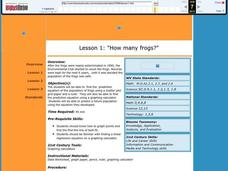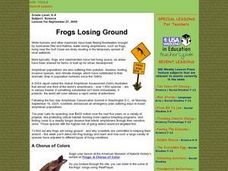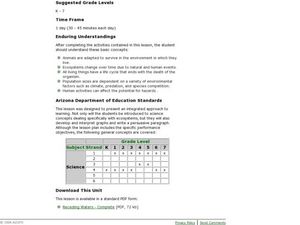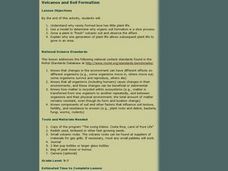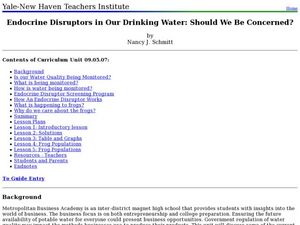Curated OER
"Croak" Science Mystery
Solve the mystery of a declining frog population! Lead your junior ecologists on an investigation that simulates actual events concerning pollution, predation, poaching, and more. Investigators read a story online, then analyze survey...
Curated OER
How Many Frogs?
Students explore the concept of linear regression. In this linear regression lesson, students find the line of best fit for a set of data pertaining to a frog population. Students use their line of best fit to predict the frog population...
Curated OER
Coqui Frog Populations
Young scholars research Coqui frogs. Students explore the life cycle of coqui frogs and discover how these frogs have become an invasive species in Hawaii.
Curated OER
Population Densities
Students explore biological impact by completing a worksheet in class. In this animal population lesson, students utilize river rocks and jars to conduct a coqui frog population role play activity. Students define a list of amphibian...
Curated OER
Frogs Losing Ground
Students explore an exhibit through an interactive program on frogs. They can listen to the different sounds frogs make and the different types of frogs. They search for the types of frogs they find in their local area.
Curated OER
Frogs: Fact or Folklore
Pupils discover how frogs are adapted to their environment. They view and discuss a Discovery Channel video on frogs and the myths surrounding frogs. In small, groups they compile data on frogs from the internet to create a Frog Fact...
Curated OER
Mystery of the Malformed Frogs Lesson Plan
Students develop an understanding of how students and volunteers can make scientific observations that can aid conservation. They read the account of the Minnesota New Country School project by Ryan Fisher, Mystery of the Malformed...
Curated OER
The Tadpole and the Frog
First graders examine the life cycle of the frog, and research frogs of the Nez Perce reservation and their requirements for survival. They observe the development of frog eggs and record their observations in science journals.
Curated OER
Exponential Population Growth
In this exponential population growth worksheet, students read word problems and determine the exponential growth of a specified populations. They find the percent of growth and compute exponential regressions. Students graph...
Curated OER
Receding Waters
Students explore the effect of environmental factors on ecosystems. In this wildlife and ecology lesson, students identify and describe the stages in a frog's life cycle. Students participate in a simulation demonstrating the...
Curated OER
Why So Many Frogs?
Students explain the different stages in the growth of a frog, then analyze and collect data to make generalizations about a larger population. They determine the survival rate of a population of tadpoles under controlled conditions.
Curated OER
The Frog Experiment
Your science class reads a silly story in which a mad scientist makes absurd conclusions about an experiment that he conducted. One at a time, he cuts off a frog's leg and commands it to jump. With three, two, and one leg, the frog...
Curated OER
Migration Woes
Students are able to describe the reproductive cycle of the gopher frog. They are able to describe the impacts of habitat loss and degradtion on gopher frog populations. Students are explained that many factors limit the survival of...
Curated OER
Is Climate Change Good for Frogs?
Students fill out a chart on how climate change would affect them and things around them. In this climate change lesson plan, students discuss how global warming affects them and amphibians and then fill out the chart that goes with it.
Curated OER
Endocrine Disruptors in Our Drinking Water: Should We Be Concerned?
Students investigate the different hormone contaminants in the water supply. In this math instructional activity, students analyze data tables and graphs. They demonstrate exponential growth and decay using frog populations.
Curated OER
Holy Habitats or Meet Metamorphosis
Students examine the metamorphosis of frogs and how it adapts to its environment. They research how world pollutants are effecting the amphibian population.
Curated OER
Animals
Second graders define and describe the characteristics of a mammal and a mammal's importance to man. They also describe the life cycle of a frog and compare and contrast a larva and an adult frog. Finally, 2nd graders study and explain...
Curated OER
The Coyote Population: Kansas Prairies
Students discover animal lifestyles by researching their ecosystem. In this animal statistics lesson, students research the geography of Kansas and discuss the reasons why wild animals survive in the open Kansas fields. Students complete...
Omaha Zoo
Monitoring Amphibians
What sort of shoes do frogs wear? Open toad sandals. If your scholars want experience collecting field samples, this is the lesson for you. After learning the proper way to collect field samples, pupils catch amphibians to test for...
Curated OER
Knocked Out by Trout
Pupils work in pairs and read an article about the pacific tree frogs being knocked out by the nonnative trout. In this invasive species lesson, students create a graphic organizer to record their findings. Once the pupils are finished...
Curated OER
Structure and Function of Vertebrates - Reading/Notetaking Guide - Amphibians
A variety of questions are presented on the amazing amphibian. Life science intellectuals complete a life cycle diagram, describe characteristics and behaviors, and fill in a metamorphosis flowchart. Content level is geared toward middle...
WK Kellogg Biological Station
Sounds of Selection
Do you want a creative and fun way to teach about natural selection? Hop to it by turning your middle school princes and princesses into frogs trying to catch as many bugs as possible in a Hungry Hungry Hippos style game. For high...
Curated OER
Wildlife Burrows
Burrowing animals are busy! Get your middle school ecologists busy as well by having them create a scale model of a burrowing population. They also design a PowerPoint or poster to explain their models.
Curated OER
Striking a Balance
Young scholars simulate animals in a food chain. In this food chain lesson plan, students are identified as grasshoppers, frogs or hawks. Popcorn is spread across a lawn and young scholars are given baggies (stomachs) and colored sashes...

